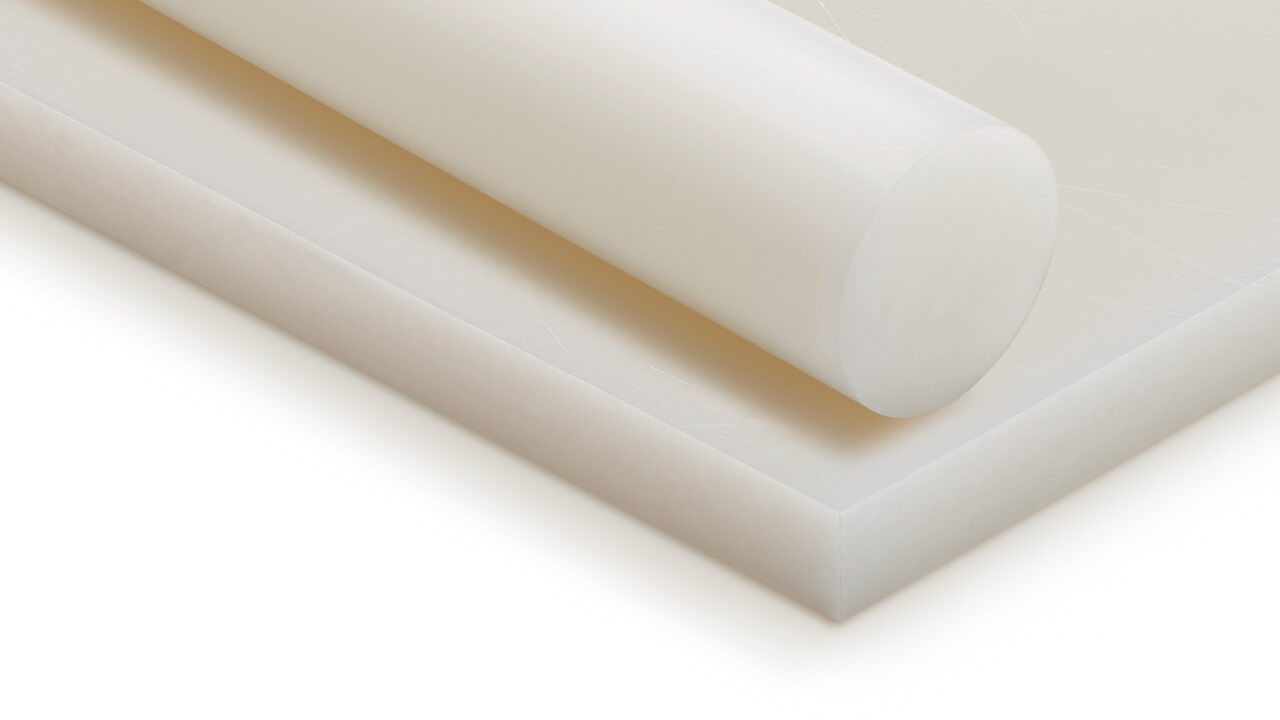Looking for High-Performance Plastic Components?
PVDF (Polyvinylidene Fluoride) is a semi-crystalline fluoropolymer. Fluoropolymers are great insulators and have hightemperature and chemical resistances. However, they are often soft and susceptible to creep failure. PVDF is a fluoropolymer with relatively high mechanical properties. Typical applications include corrosive environments requiring the chemical resistance of a fluoroplastic, while also needing the higher mechanical properties than a PTFE or PCTFE can provide. It has a long-term service temperature of 300 °F.
PVDF is white in color and is available in a wide range of rod and sheet sizes. It is also commonly used to make tubing or films for insulating applications. It is also inherently non-flammable and FDA compliant and therefore commonly utilized in food processing and chemical processing applications. Its electrical and flame properties have lead to PVDF being commonly used it lithium-ion batteries and for cable jackets as well.
It is easily machined with common metal working equipment. Tolerances of +/-.001 can be achieved with experience
| Specification | Test | Value | Units |
| Specific Gravity, 73°F | D792 | 1.78 | - |
| Tensile Strength @ Yield, 73°F | D638 | 7,800 | psi |
| Tensile Modulus of Elasticity, 73°F | D638 | 350,000 | psi |
| Tensile Elongation (at break), 73°F | D638 | 35 | % |
| Flexural Strength, 73°F | D790 | 14,700 | psi |
| Flexural Modulus of Elasticity | D790 | 410,000 | psi |
| Shear Strength, 73°F | D732 | - | psi |
| Compressive Strength - Ultimate | psi | ||
| Compressive Strength at 2% Deformation | D695 | psi | |
| Compressive Strength at 10% Deformation | D695 | 11,600 | psi |
| Deformation Under Load | % | ||
| Compressive Modulus of Elasticity, 73°F | D695 | 160,000 | |
| Compressive Strength ⊥ to Laminate (Modulus) | psi | ||
| Compressive Strength ⊥ to Laminate (Yield) | psi | ||
| Compressive Strength ⊥ to Laminate (Ultimate) | psi | ||
| Hardness, Durometer (Shore "D" scale) | D2240 | 79 | |
| Hardness, Rockwell (Scale as noted) | D785 | M79 | Rockwell M |
| Izod Impact, Notched @ 73°F | D256 Type A | 1.97 | ft.lbs/in. of notch |
| Coefficient of Friction (Dry vs Steel) Static | PTM 55007 | - | |
| Coefficient of Friction (Dry vs Steel) Dynamic | PTM 55007 | - | |
| Maximum Static Bearing Load (P) | PTM 55007 | - | psi |
| Maximum Unlubricated No Load Bearing Velocity (V) | PTM 55007 | - | ft/minute |
| Maximum Limiting PV (Unlubricated) | PTM 55007 | - | psi x ft/min. |
| Wear Factor "K" x 10-10 | PTM 55010 | - | Cubic in.-min/ft.lbs.hr |
| Sand Wheel Wear/Abrasion Test | - | UHMW=100 | |
| Minimum Mating Surface Hardness | - | Rockwell (Brinnell) | |
| Coefficient of Linear Thermal Expansion | E-831 (TMA) | 7.1 | in/in/°F x 10-5 |
| Coefficient of Thermal Expansion // to Laminates | E-831 (TMA) | 7.1 | in/in/°F x 10-5 |
| Coefficient of Thermal Expansion I to Laminates | E-831 (TMA) | 7.1 | in/in/°F x 10-5 |
| Softening Point | °F | ||
| Heat Deflection Temperature 264 psi | D648 | 235 | °F |
| Embrittlement Temperature | -65 | °F Min. | |
| Continuous Service Temperature in Air | 300 | °F Max. | |
| Short Term Service Temperature | 300 | °F Max. | |
| Tg-Glass Transition (Amorphous) | D3418 | -31 | °F |
| Melting Point (Crystalline) Peak | D3418 | 342 | °F |
| Thermal Conductivity | F433 | 1.32 | BTU-in/(hr/ft2°F) |
| Dielectric Strength Short Term | D149 | 510 | Volts/mil |
| Surface Resistivity | D257 | >1x1010 | ohm/cm |
| Volume Resistivity | D257 | >5x1014 | ohm/cm |
| Dielectric Constant, 106 Hz | D150 | 7.0 | |
| Dissipation Factor, 106 Hz | D150 | 0.02 | |
| Flammability @ 3.1mm(1/8 in.) UL94 | UL94 | V-O | |
| Arc Resistance | seconds | ||
| Water Absorption, Immersion 24 Hours | D570 (2) | 0.02 | % |
| Water Absorption, Immersion Saturation | D570 (2) | - | % |
| Machinability Rating | 3 | 1=easy, 10=difficult | |
| Rod Diameter Availability (Off the Shelf) | .375-4.0 | inches | |
| Sheet Thickness Availability (Off the Shelf) | .250-2.5 | inches |
